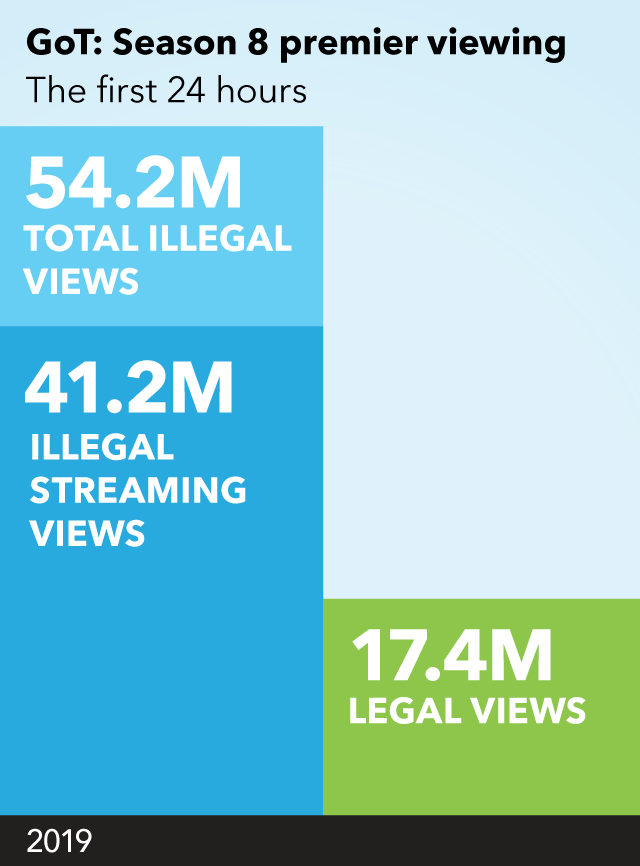Digital Rights Management (DRM) is a critical piece of the modern content security puzzle and media workflow. Applying a variety of tools – each at the right time – is critical to avoid costly piracy and leakage repercussions. In a series of blog posts over the next several weeks, we’ll review today’s content piracy problem, and detail the solutions available for preventing it – including DRM, watermarking and fingerprinting – and how they work together in a holistic approach to content security.
What’s Fueling Piracy?
With consumer demand for premium entertainment at an all-time high and adoption of new technologies growing exponentially, many factors are coming together, creating an environment ripe for piracy.
Streaming Now the Norm
We’ve undergone a big shift from the days when content pirates copied DVDs and other physical media for illegal distribution. Today, streaming video has become the norm. In 2018, subscriptions to online video services were up 27% over 2017, surpassing cable for the first time with 613.3 million subscribers. Following on from this trend, 96% of visits to piracy sites for TV content in 2017 were made via web streaming sites. Making access and re-distribution easier for hackers and readily available for consumers anywhere in the world, streaming has definitely ignited the flames of piracy.
 Golden Age of Entertainment
Golden Age of Entertainment
Despite changing delivery models, or perhaps because of them, consumers are watching more entertainment than ever. In 2018, consumers around the globe spent US$96.8 billion on theatrical and home entertainment, up almost 10% from 2017.
And with premium TV content in high demand from hungry fans, making top talent and production skill sets a hot commodity, shows such as American Crime Story, Stranger Things, Westworld and The Crown are seeing production costs rising as high as US$6 or $8 million per episode as they seek to compete on production quality. Game of Thrones – the king of all content – has reached an episode high of US$15 million.
The escalating demand for entertainment, competition among creators, and high value of the content itself, is feeding a piracy frenzy. TV and film accounted for ⅔ of all piracy activity in 2018, while the first episode of the final season of Game of Thrones was pirated over 54.2 million times around the globe within the first 24 hours of its premiere on HBO’s platforms, far eclipsing HBO’s official viewing figure of 17.4 million. Streaming accounted for 76.6% of unlicensed views. And even as new technologies dominate, old school piracy – including low-quality video capture via cameras in movie theaters – still persists as recently as April 2019, as the theft of Avengers: Endgame demonstrates.
Live Streaming Sports
TV shows and movies aren’t the only premium content that pirates seek. In 2018, revenue from sports media rights in North America alone amounted to over US$20 billion, and these deals are rapidly moving online, driven by consumers who want to cut the cord with cable TV, and are willing to pay up to US$39 per month for the convenience and flexibility of streaming games and other sports content to any device. With fans willing to do anything to see their favorite teams play, streaming sports is attractive to pirates, especially for a younger audience. In fact 54% of millennials admitted to researchers to having watched illegal streams of live sports – ⅓ of them regularly.
 The Power of Mobile
The Power of Mobile
There are over 3 billion smartphone users globally, all with a powerful device at their fingertips with the ability to access content anytime, anywhere. So it’s not surprising that 52% of visits to TV piracy sites in 2017 were accessed via mobile devices, rising up the ranks to become the most popular way of consuming illegitimate content. This is powerful fuel.
The Reach of Social Media
Over 2.7 billion people across the globe use social media, exposing them to sites where content pirates openly advertise and stream illegal copies of the latest films and shows. These social platforms provide a web-scale tool for proliferating illegal content, where, during the 2018 World Cup, over 41 million viewers watched illegal streams. And social media use is still increasing, with projected growth of over 11% – up to 3.02 billion people – by 2021.
Casual Consumer Attitudes
As is quite evident from the details above, consumers have very casual attitudes about watching pirated content. This is especially true for younger viewers. 93% of Millennials in a study by LaunchLeap did not feel guilty watching illegal content. So clearly most consumers can’t be counted on to do the right thing when given the opportunity to watch what they want to watch – illegal or not.
Powerful Fuel
As you can see, there is powerful fuel everywhere around us, making it easier and more lucrative for pirates to steal and re-distribute illegal content, and for consumers to access and watch it. For content owners, this is an expensive problem. In our next blog post we’ll explore how big the piracy problem is, and its cost to content owners.
In the meantime, please download our infographic on content piracy for a high-level view of the problem. And we’ll alert you when the next post in this series is available.
UPDATE: The second post in this series “Content Piracy Is a Big Problem and It’s Hurting Your ROI” can now be viewed here.








